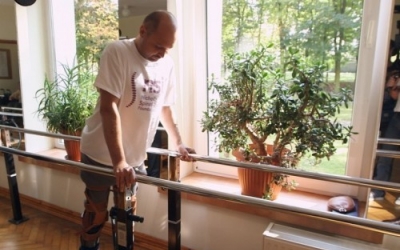- Latest news▼
-
12:16, April 19 Scientists grow human mini-lungs in lab

-
10:23, April 19 JAMA Oncology: Urine test can help rule out high-grade prostate cancer with almost 100% accuracy, study shows

-
18:00, April 18 Daily Mail: Elderly woman in China gets infected with brain-eating amoeba

-
14:19, April 18 Obesity: exercising before breakfast helps you lose weight faster

-
10:42, April 18 The Conversation: childhood trauma can cause pathological hoarding

-
08:37, April 18 Daily Mail: Satiating food reduces cravings for sweets, nutritionist says

-
18:22, April 17 First Armenian-German Conference entitled “Heart Failure Spring School”

-
08:38, April 17 Why do kids usually recover from COVID-19 more easily than adults?

-
14:37, April 16 Daily Mail: intermittent fasting is not suitable for children and women before their periods

-
16:41, April 15 Cell: in carriers of defective BRCA2 gene, sugar consumption increases cancer risk

-
15:04, April 15 305 cases of measles recorded in Armenia so far in 2024

-
14:38, April 15 Food and Environmental Virology: tea contributes to effective coronavirus control

-
12:41, April 15 Daily Mail: vitamin A, B3 and E supplements can be dangerous

-
10:56, April 15 Diabetes Care: evening physical activity is good for the heart

-
08:27, April 15 Women are more susceptible to blood loss and death during bypass surgery than men, researchers say

All materials
Paralysed man walks again after cell transplant

A paralysed man has been able to walk again after a pioneering therapy that involved transplanting cells from his nasal cavity into his spinal cord, BBC reports.
Darek Fidyka, who was paralysed from the chest down in a knife attack in 2010, can now walk using a frame.
The treatment, a world first, was carried out by surgeons in Poland in collaboration with scientists in London.
Details of the research are published in the journal Cell Transplantation.
BBC One's Panorama programme had unique access to the project and spent a year charting the patient's rehabilitation.
Darek Fidyka, 40, from Poland, was paralysed after being stabbed repeatedly in the back in the 2010 attack.
He said walking again - with the support of a frame - was "an incredible feeling", adding: "When you can't feel almost half your body, you are helpless, but when it starts coming back it's like you were born again."
Prof Geoff Raisman, chair of neural regeneration at University College London's Institute of Neurology, led the UK research team.
He said what had been achieved was "more impressive than man walking on the moon".
The treatment used olfactory ensheathing cells (OECs) - specialist cells that form part of the sense of smell.
OECs act as pathway cells that enable nerve fibres in the olfactory system to be continually renewed.
In the first of two operations, surgeons removed one of the patient's olfactory bulbs and grew the cells in culture.
Two weeks later they transplanted the OECs into the spinal cord, which had been cut through in the knife attack apart from a thin strip of scar tissue on the right. They had just a drop of material to work with - about 500,000 cells.
About 100 micro-injections of OECs were made above and below the injury.
Four thin strips of nerve tissue were taken from the patient's ankle and placed across an 8mm (0.3in) gap on the left side of the cord.
The scientists believe the OECs provided a pathway to enable fibres above and below the injury to reconnect, using the nerve grafts to bridge the gap in the cord.
Before the treatment, Mr Fidyka had been paralysed for nearly two years and had shown no sign of recovery despite many months of intensive physiotherapy.
This programme of exercise - five hours per day, five days a week - has continued after the transplant at the Akson Neuro-Rehabilitation Center in Wroclaw.
Mr Fidyka first noticed that the treatment had been successful after about three months, when his left thigh began putting on muscle.
Six months after surgery, Mr Fidyka was able to take his first tentative steps along parallel bars, using leg braces and the support of a physiotherapist.
Two years after the treatment, he can now walk outside the rehabilitation centre using a frame.
He has also recovered some bladder and bowel sensation and sexual function.
Follow NEWS.am Medicine on Facebook and Twitter
- Video
- Event calendar
- Archive
- Most read
month
week
day
- WHO: Nigeria pioneers revolutionary meningitis vaccine 1184
- One-third of women experience menstruation-related migraines, most often during premenopause - study 1171
- Daily Mail: vitamin A, B3 and E supplements can be dangerous 1022
- Food and Environmental Virology: tea contributes to effective coronavirus control 1014
- Cell: in carriers of defective BRCA2 gene, sugar consumption increases cancer risk 987
- 305 cases of measles recorded in Armenia so far in 2024 979
- Women are more susceptible to blood loss and death during bypass surgery than men, researchers say 969
- Diabetes Care: evening physical activity is good for the heart 925
- Daily Mail: intermittent fasting is not suitable for children and women before their periods 796
- First Armenian-German Conference entitled “Heart Failure Spring School” 578
- Why do kids usually recover from COVID-19 more easily than adults? 464
- Obesity: exercising before breakfast helps you lose weight faster 463
- The Conversation: childhood trauma can cause pathological hoarding 460
- Daily Mail: Elderly woman in China gets infected with brain-eating amoeba 438
- Daily Mail: Satiating food reduces cravings for sweets, nutritionist says 433
- Find us on Facebook
- Poll





